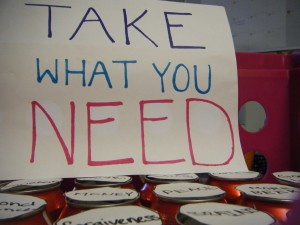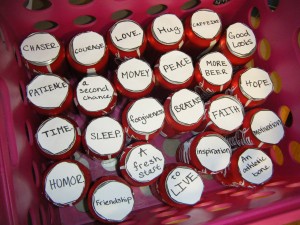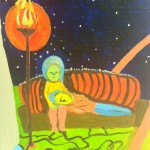Right now, if I asked you if you needed something, what would you say?
Would it be a new car? Money? Perhaps you are needing something on a more intellectual basis like inspiration, motivation, or knowledge.
For this assignment, with the only instructions being to hand out 24 individual sodas and to record the experience, I decided to create the illusion of giving people what they “need” with the help of a Coke can, or 24.
I wrote down needs that people would really have to consider, for instance: a second chance, time, faith, courage, etc. Then, upon realizing I was  planning to hand these out on a hill to a bunch of young adults who had been tailgating all afternoon in preparation for thefirst Morningside football game of the season, I decided to throw some other “needs” in the mix. These “needs” went along the lines of: chaser, more beer, an athletic bone, sleep, etc.
planning to hand these out on a hill to a bunch of young adults who had been tailgating all afternoon in preparation for thefirst Morningside football game of the season, I decided to throw some other “needs” in the mix. These “needs” went along the lines of: chaser, more beer, an athletic bone, sleep, etc.
The reaction of these 18 to 23 year old Morningside College students and their responses to what a “need” meant to them, interested me.
So I walked up the massive hill with my crate of Coke cans, and as I’m trying to keep my footing halfway to the top, I see a woman running towards me.
“Is that beer? Do you have beer?” she asked.
“No, but I have a refreshing Coke,” I responded, trying my best to sound convincing. I found this to be a great opportunity to figure out how the rest of the students would possibly react.
The woman gave a disappointing, or maybe disapproving, sigh and walked away.
That is when I thought, Oh great… These people don’t want refreshing Cokes! They want alcohol, booze, more beer! How are they going to take to this project?
However, I continued my trek up the steep hill, and decided I wasn’t backing down. More so because that was one giant hill, and my apartment seemed forever away.
Curiosity arose as I walked up to the group of hill-goers, or as they like to refer to themselves “Allee-holics,” a student formed group named after our Allee-Verdoorn gym on campus. They have deemed themselves the unofficial, slightly obnoxious, cheerleaders for all the sports games (especially football, basketball, and volleyball).
I hadn’t quite thought through my approach, should I walk up to people and ask them to pick one, or should I just set the crate down and let people respond to it however they want?
I opted for the first approach, at least at first. I went up to a group, two guys and one girl I knew from the soccer team. She wasn’t drinking, so I figured she could use a Coke.
“Whaaat is thisss?” asked the first boy in a suspicious almost criticizing tone.
The girl in the group recognized what I was doing and tried to explain, which I was thankful about.
“Take what you need,” she said, “You have to pick something that you need right now.”
Then, she reached for the can that read “More Beer,” which I found to be pretty fitting since it was known that the women’s soccer team, which she was part of, was having a dry-season (zero alcohol).
In the meantime the second boy in the group had been reading them over. He had selected the can that read “A Second Chance,” but after having read the rest of them he put the can back.
“Time,” he read, and opted for that can instead.
With my cursed inquiring nature, and the fact that this was all an assignment for my News Feature and Writing class, I asked him why he had changed his mind.
“Because with time, I wouldn’t need a second chance. I would just have more time to do things,” he said.
I don’t know if I would have used that choice of words, but I think I understood what he meant.
The first boy had selected during that time the can that had read “Sleep.” With his bloodshot eyes it definitely looked like he could use more. Or, that could have just been the effect of the amount of alcohol he had probably ingested prior, either way.
After the group of the three walked away, I found people just pointing and staring. I’m not one to enjoy being the center of attention, so I thought I would now go for the second approach.
The Allee-holics had been done grilling for sometime, so I sat the crate on a ledge protruding from the grill. Then I placed the sign that read “Take What You Need” above the crate, and walked away.
For a while the crate was ignored, even avoided. However, the more alcohol intake, the snoopier people became.
Sooner or later, a couple girls walked up to the crate, looking it over. There was laughter, one girl trying to tell the other, “Oh no, you definitely need this one.”
They eventually chose and walked away, satisfied with their choices and a free Coca-Cola. One girl even showing their friends which one she had decided on.
Then, as if someone had heard me verbalize my worst nightmare, a crowd of intoxicated guys swarmed the crate. I tried my hardest to remain calm, maybe they were just curious and were just going to take one each and walk away, pondering to themselves what it really was they needed out of this life.
Yeah, who was I kidding?
They read them all, however, and were making jokes trying to give each other the ones they deemed most fitting for each guy in the group.  Laughter was radiating from the area surrounding the crate, but the football game was still underway, so not many people noticed them.
Laughter was radiating from the area surrounding the crate, but the football game was still underway, so not many people noticed them.
I kept glancing over at the group, but at the same time trying to remain invisible to them so I could take a few mental notes on what they were saying and doing. Then, right as I thought I could breathe again, and my project was going to be okay, it took a bit of a turn.
One of the guys grabbed the sign I had made that read, “Take What You Need,” and blew his nose with it. At first I was furious. Then, in the midst of trying to calm myself down and hold myself back from stomping over to the obnoxious bunch to give them a few choice words, I pondered… Maybe that was exactly what he needed, something to blow his nose on.
I let it go, and they eventually all walked away. There was one soda left in the crate, and I was more than ready to be done with it. Besides, there was no longer a sign to explain what was going on anyway.
I thought my efforts to be somewhat successful depending on how you looked at it. It came down to me needing people to take the sodas off my hands so that I could accomplish an assignment, and these parched Morningside students sitting atop a hill on a hot day needed a refreshing drink. Perhaps I got through to them to think about their individual needs, perhaps I did not. Either way I got some kind of a story out of it; I got what I needed.








